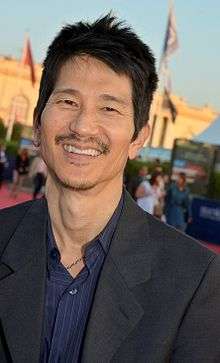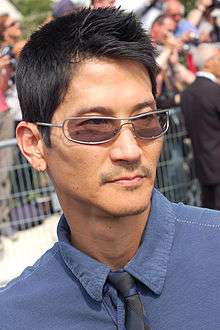Gregg Araki
| Gregg Araki | |
|---|---|
 Araki at the Deauville American Film Festival in September 2014 | |
| Born |
December 17, 1959 Los Angeles, California, United States |
| Nationality | American |
| Education |
University of California, Santa Barbara (B.A. 1982) University of Southern California (M.F.A. 1985) |
| Occupation | Filmmaker and film director |
| Years active | 1987–present |
| Style | New Queer Cinema |
| Home town | Santa Barbara, California, United States |
| Awards | Cannes Film Festival Queer Palm (2010) |
Gregg Araki (born December 17, 1959) is an American independent filmmaker and film director involved heavily with New Queer Cinema. His film Kaboom was the first ever winner of the Cannes Film Festival Queer Palm awarded in 2010.
Early life and education
Araki was born in Los Angeles on December 17, 1959 to Japanese American parents.[1][2] He grew up in nearby Santa Barbara, California and enrolled in college at the University of California, Santa Barbara.[3] He graduated with a B.A. from UCSB in 1982.[2][4] He later attended the University of Southern California's School of Cinematic Arts, where he graduated with a M.F.A. in 1985.[2][3][5]
Career
Low-budget beginnings
Araki made his directorial debut in 1987 with Three Bewildered People in the Night. With a budget of only $5,000 and using a stationary camera, he told the story of a romance between a video artist, her sweet-heart and her gay friend.[3][6] Two years later, Araki followed up with The Long Weekend (O' Despair), another film with a $5,000 budget.[3][6] His third film, The Living End, saw an increase to $20,000.[6] He had to shoot his early movies often spontaneously and lacking proper permits.[2]
Despite the financial constraints, Araki's films received critical acclaim. He received awards from the Locarno International Film Festival and the Los Angeles Film Critics Association, with an additional nomination for a Sundance Film Festival award.[2][7]
Teen Apocalypse Trilogy
Araki's next three movies — Totally Fucked Up, The Doom Generation, and Nowhere — were collective dubbed the "Teen Apocalypse Trilogy".[3] The trio has been characterized as "... teen alienation, hazy sexuality and aggression."[8] A former student of his at UC Santa Barbara, Andrea Sperling, co-produced the films with him.[9]
The trifecta saw Araki work with increasingly more notable actors and actresses including Rose McGowan, Margaret Cho, Parker Posey, Guillermo Díaz, Ryan Phillippe, Heather Graham, and Mena Suvari among others.
The Trilogy received varying degrees of reviews, from a thumbs down and "zero stars" by Roger Ebert's to "Literally the Best Thing Ever" by Rookie and being heralded as cult classics.[10][11][12]

Subsequent efforts
Araki's following film, Splendor, was both a response to the controversy surrounding his ongoing relationship with actress Kathleen Robertson (despite identifying as gay) and an homage to screwball comedies of the 1940s and 1950s.[2][3] Hailed as the director's most optimistic film to date, it made its premiere at the 1999 Sundance Film Festival.[13]
Araki's next project was the ill-fated MTV production This Is How the World Ends, which was originally planned with a budget of $1.5 million.[14] He viewed it as a chance to reach the masses through MTV's viewership and signed on to do the project despite the budget being cut to $700,000.[2][14] Araki wrote, directed, and shot the pilot episode, but ultimately MTV decided against the project and the effort never aired.[2][14]
Following a short hiatus, Araki returned in 2004 with the critically acclaimed Mysterious Skin, based on the 1995 Scott Heim novel of the same name.[2] This marked the first time that Araki worked with someone else's source material.[14][15]
Araki's next feature was the stoner comedy Smiley Face, featuring Anna Faris, Adam Brody, and John Krasinski, written by Dylan Haggerty. It marked a stark change from the dark, heavy drama of Mysterious Skin, a change purposely planned by Araki.[14][15] It received very favorable reviews, with some describing it as another of Araki's potential cult classics.[14][16][17]
Kaboom marked Araki's tenth film and made its premiere at the 2010 Cannes Film Festival. It was awarded the first ever Queer Palm for its contribution to lesbian, gay, bisexual, and transgender issues.[18]
Style
One consistent feature of Araki's work to date is the presence of music from the shoegazing genre as film soundtracks, first seen on Totally Fucked Up and heavily so on the films Nowhere and Mysterious Skin.[1][19] Both The Living End and Nowhere owe their titles to this shoegaze influence; The Living End after like-named The Jesus and Mary Chain song and Nowhere after Ride's album entitled Nowhere.[20]
Awards and honors
In 2010, Kaboom was named the first ever winner of the Cannes Film Festival Queer Palm.[18] Araki has also been honored with the 2006 Filmmaker on the Edge Award at the Provincetown International Film Festival.[21] In 2013, Araki was recognized by the Museum of Arts and Design in New York City with the retrospective God Help Me: Gregg Araki.[22][23][24]
Personal life
Araki has previously self-identified as "a gay Asian American".[25] Contrary to the statement, beginning in 1997 he had a relationship with actress Kathleen Robertson, whom he directed in Nowhere.[26][27][28] The relationship ended in 1999. Araki has since mainly dated men and now identifies as bisexual.
Filmography
| Year | Title | Notes |
|---|---|---|
| 1987 | Three Bewildered People in the Night | Debut |
| 1989 | The Long Weekend (O' Despair) | |
| 1992 | The Living End | |
| 1993 | Totally Fucked Up | Part 1 of "Teen Apocalypse Trilogy" |
| 1995 | The Doom Generation | Part 2 of "Teen Apocalypse Trilogy" |
| 1997 | Nowhere | Part 3 of "Teen Apocalypse Trilogy" |
| 1999 | Splendor | |
| 2000 | This Is How the World Ends | Television pilot |
| 2004 | Mysterious Skin | Based on the book by Scott Heim |
| 2007 | Smiley Face | |
| 2010 | Kaboom | |
| 2014 | White Bird in a Blizzard | Based on the novel |
| 2016 | American Crime | Season Two: Episode Three |
| 2016 | Red Oaks | Two episodes |
References
- 1 2 Rich, B. Ruby (March 26, 2013). New Queer Cinema: The Director’s Cut. Durham, North Carolina: Duke University Press. ISBN 9780822399698.
- 1 2 3 4 5 6 7 8 9 Prono, Luca (December 30, 2007). Encyclopedia of Gay and Lesbian Popular Culture. Santa Barbara, California: ABC-CLIO. ISBN 9780313335990.
- 1 2 3 4 5 6 Hart, Kylo-Patrick R. (September 20, 2010). Images for a Generation Doomed: The Films and Career of Gregg Araki. Lanham, Maryland: Rowman & Littlefield. ISBN 9780739139974.
- ↑ "UCSB Notable Alumni: Art". alumni.ucsb.edu. UC Santa Barbara Alumni Association. Retrieved December 17, 2014.
- ↑ "USC Filmmakers Descend on Sundance". news.usc.edu. Retrieved December 17, 2014.
- 1 2 3 Chua, Lawrence (Fall 1992). "Gregg Araki". Bomb. New Art Publications (41). Retrieved December 17, 2014.
- ↑ "Do The Right Thing wins honors". The Item. Sumter, South Carolina. December 21, 1989. Retrieved December 17, 2014.
- ↑ O'Connell, Ryan (January 31, 2011). "The Work of Gregg Araki: Teenagers, Aliens and Shoegaze". thoughtcatalog.com. Retrieved December 17, 2014.
- ↑ Taubin, Amy (September 7, 1999). "Market Forces". The Village Voice. New York City. Retrieved July 21, 2016.
- ↑ Ebert, Roger (November 10, 1995). "THE DOOM GENERATION". rogerebert.com. Retrieved December 17, 2014.
- ↑ Cills, Hazel (June 13, 2012). "Literally the Best Thing Ever: Gregg Araki's Totally Effed-Up L.A.". Rookie. Retrieved December 17, 2014.
- ↑ McAllister, Matt (September 6, 2011). "Gregg Araki Interview: At World's End". futuremovies.co.uk. Retrieved December 17, 2014.
- ↑ "1999 Sundance Film Festival - Splendor". history.sundance.org. Sundance Film Festival. Retrieved December 18, 2014.
- 1 2 3 4 5 6 Tasker, Yvonne, ed. (October 21, 2010). Fifty Contemporary Film Directors. London: Routledge. ISBN 9781136919459.
- 1 2 Smith, Damon (February 2008). "Rebel, Rebel". Bright Lights Film Journal. Oakland, California (59). Retrieved December 18, 2014.
- ↑ Konrad, Todd. "Smiley Face". independentfilmquarterly.com. Retrieved December 18, 2014.
- ↑ Mottram, James (January 26, 2007). "Brits reign at Sundance". The Independent. London. Retrieved December 18, 2014.
- 1 2 Tsiokos, Basil (May 23, 2010). "UPDATE: "Kaboom" Claims First Queer Palm". indiewire.com. Indiewire. Retrieved December 17, 2014.
- ↑ O'Neill, Phelim (2011-08-05). "Gregg Araki's films are giving the US a crash course in shoegazing". The Guardian. ISSN 0261-3077. Retrieved 2016-11-17.
- ↑ O'Neill, Phelim (August 5, 2011). "Gregg Araki's films are giving the US a crash course in shoegazing". The Guardian. London. Retrieved December 18, 2014.
- ↑ "FILMMAKER ON THE EDGE". ptownfilmfest.org. Provincetown International Film Festival. Retrieved December 17, 2014.
- ↑ "God Help Me: Gregg Araki". Museum of Arts and Design. Museum of Arts and Design. Retrieved 5 August 2015.
- ↑ Renninger, Bryce J. "Never-Aired MTV Pilot & Master Class at Museum of Art Design's Gregg Araki Retrospective". Indiewire. Indiewire. Retrieved 5 August 2015.
- ↑ Grossman, Jeremy. "Cult filmmaker Gregg Araki talks career retrospective". Washington Square News. New York University. Retrieved 5 August 2015.
- ↑ Yutani, Kimberly (1996). "Gregg Araki and the Queer New Wave". In Leong, Russell. Asian American Sexualities: Dimensions of the Gay and Lesbian Experience. Psychology Press. p. 177. ISBN 9780415914376.
- ↑ Szymanski, Michael (July 20, 1997). "Having It Both Ways". Los Angeles Times. Los Angeles, California. Retrieved December 17, 2014.
- ↑ Turner, Megan (September 8, 1999). "STRANGE BEDFELLOWS: GAY DIRECTOR FALLS FOR '90210' BABE". New York Post. New York City, New York. Retrieved December 17, 2014.
- ↑ Lim, Dennis (January 14, 2011). "Young and Restless Never Gets Old". The New York Times. New York City, New York. Retrieved December 17, 2014.
External links
| Wikimedia Commons has media related to Gregg Araki. |
- Gregg Araki at the Internet Movie Database
- Young, Beautiful, and F***ed: A conversation with Gregg Araki and other members of The Doom Generation in Bright Lights Film Journal